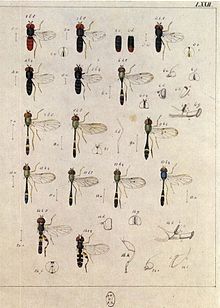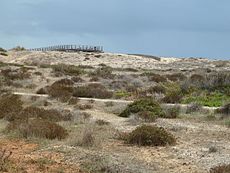| Paragus haemorrhous | |
|---|---|

| |

| |
| Original figures in Meigen's Europäischen Zweiflügeligen | |
| Scientific classification | |
| Domain: | Eukaryota |
| Kingdom: | Animalia |
| Phylum: | Arthropoda |
| Class: | Insecta |
| Order: | Diptera |
| Family: | Syrphidae |
| Genus: | Paragus |
| Subgenus: | Pandasyophthalmus |
| Species: | P. haemorrhous |
| Binomial name | |
| Paragus haemorrhous Meigen, 1822 | |
| Synonyms | |
| |
Paragus haemorrhous, the Black-backed Grass Skimmer is a common widespread species of hoverfly found in many parts of Europe, Africa and the Nearctic. Hoverflies can remain nearly motionless in flight. The adults are also known as flower flies for they are commonly found on flowers from which they get both energy-giving nectar and protein-rich pollen. The larvae are predators on aphids.
Description
For terminology
Speight key to genera and glossary
external link to inaturalist images
- Size
4.3–5.9 mm (0.17–0.23 in)
- Head
The face is yellow, moderately projecting, with a black median stripe in both sexes. The third antennal joint is sordid reddish below. The eyes are uniformly pilose."
- Thorax
The scutellum entirely black.
- Abdomen
Segment 1 is black and well-developed. Segment 2 is black or has a posterior margin that is red. Segments 3 through 5 are usually entirely red-orange to dark red in males. The superior lobe varies in shape and size, with an apex that is nearly truncate to strongly oblique, and with a length from one to two times that of the surstylus.
- Wings
The wings are hyaline with a brownish grey stigma.
- Legs
The legs are yellow and light brownish yellow. The basal half of the femora are black. The hind tibia is usually with apical half yellow-orange.
Females cannot be identified.
See references for determination.
Distribution
Palearctic: Fennoscandia south to Iberia and the Mediterranean basin, Israel and Turkey, Ireland eastward through Central Europe and Southern Europe (Italy, the former Yugoslavia) into European Russia. Nearctic: from the Yukon south to Costa Rica also in parts of the Afrotropical region.

Biology
Habitat: Unimproved grassland, heathland, garrigue, dune grassland, open areas and pathsides in forest up to the Larix/Pinus uncinata zone, fen meadow. Flowers visited include umbellifers, Calluna, Jasione montana, Matricaria, Origanum, Polygonum, Potentilla, Solidago, Stellaria. It flies May to September. The larva feeds on aphids on low herbaceous plants.
Molecular genetics

As "based on both morphological and molecular evidence", Paragus haemorrhous Meigen 1822, Paragus coadunatus (Rondani, 1847) and Paragus ascoensis Goeldlin de Tiefenau & Lucas, 1981 appear to be synonyms of Paragus tibialis (Fallén, 1817)". Rojo et al. (2006).
References
- Stubbs, Alan E.; Falk, Steven J (1983). British Hoverflies: An Illustrated Identification Guide (2nd ed.). London: British Entomological and Natural History Society. pp. 253, xvpp. ISBN 1-899935-03-7.
- Ball, S.G.; Morris, R.K.A. (2000). Provisional Atlas of British Hoverflies (Diptera, Syrphidae). Monks Wood, UK: Biological Record Centre. 167 pages. ISBN 1-870393-54-6.
- Rotheray G. (1993). Colour Guide to Hoverfly Larvae Diptera, Syrphidae in Britain and Europe. Dipterists Forum. pdf
- Van Veen, M. (2004). Hoverflies of Northwest Europe: identification keys to the Syrphidae. 256pp. KNNV Publishing, Utrecht.addendum.
- Van der Goot, V.S. (1981). De zweefvliegen van Noordwest - Europa en Europees Rusland, in het bijzonder van de Benelux. KNNV, Uitgave no. 32: 275pp. Amsterdam.
- Bei-Bienko, G.Y. & Steyskal, G.C. (1988). Keys to the Insects of the European Part of the USSR, Volume V: Diptera and Siphonaptera, Part I. Amerind Publishing Co., New Delhi. ISBN 81-205-0080-6.
- Coe, R.L. (1953). "Diptera: Syrphidae". Handbks. Ident. Br. Insects 10(1): 1-98. R. Ent. Soc. London. pdf.
- Fauna Europaea.
- Peck, L.V. (1988). "Syrphidae". In: Soos, A. & Papp, L. (eds.). Catalogue of Palaearctic Diptera 8: 11-230. Akad. Kiado, Budapest.
- Vockeroth, J.R. (1992). The Flower Flies of the Subfamily Syrphinae of Canada, Alaska, and Greenland (Diptera: Syrphidae). Part 18. The Insects and Arachnids of Canada. Ottawa, Ontario: Canadian Government Pub Centre. pp. 1–456. ISBN 0-660-13830-1.
- Speight, M.C.D. (2011). "Species accounts of European Syrphidae (Diptera)" (PDF). Syrph the Net, the database of European Syrphidae. 65: 285pp.
- de Buck, N. (1990) Bloembezoek en bestuivingsecologie van Zweefvliegen (Diptera, Syrphidae) in het bijzonder voor België. Doc.Trav. IRSNB, no.60, 1-167.
- Rojo, S., Ståhls, G., Pérez-Bañon, C. & Marcos-García, M.-Á. (2006) Testing molecular barcodes:invariant mitochondrial DNA sequences vs the larval and adult morphology of West Palaearctic Pandasyophthalmus species (Diptera: Syrphidae: Paragini). Eur.J.Entomol., 103: 443-458.